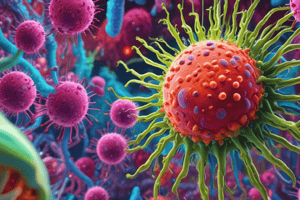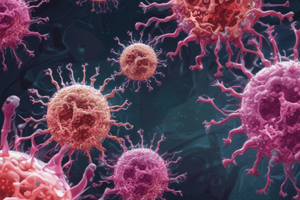Podcast
Questions and Answers
What is the primary function of hemagglutinin in the context of viral adsorption?
What is the primary function of hemagglutinin in the context of viral adsorption?
- Promoting the release of viral nucleic acid from the capsid during uncoating.
- Assisting influenza viruses in binding to glycoprotein receptors on respiratory epithelium. (correct)
- Facilitating the entry of HIV into host cells.
- Aiding in the replication of viral DNA within the host cell's nucleus.
How does Viropexis, as a mechanism of viral penetration, facilitate viral entry into a host cell?
How does Viropexis, as a mechanism of viral penetration, facilitate viral entry into a host cell?
- Through the enzymatic breakdown of the host cell membrane, allowing the virus to diffuse into the cell.
- By directly injecting the viral genome into the host cell's cytoplasm.
- By triggering the host cell to engulf the virus, enclosing it in an endosome which then releases the virus into the cytoplasm. (correct)
- By fusing the viral envelope directly with the host cell membrane, releasing the viral contents inside.
Which of the following statements accurately describes the eclipse phase of viral replication?
Which of the following statements accurately describes the eclipse phase of viral replication?
- The phase characterized by the detection and assembly of complete, infectious virions outside the host cell.
- The stage where the virus is actively attaching to the host cell membrane via specific receptor interactions.
- The period during which the virus remains dormant within the host cell, showing no signs of replication or activity.
- The period immediately following viral entry into the host cell, during which the virus is actively replicating, but no complete virions are detectable. (correct)
In the context of viral replication, what is the role of lysosomal enzymes during the uncoating process?
In the context of viral replication, what is the role of lysosomal enzymes during the uncoating process?
How does the replication strategy of Poxviruses differ from that of most other DNA viruses?
How does the replication strategy of Poxviruses differ from that of most other DNA viruses?
Which of the following is a characteristic of the 'eclipse phase' in the viral replication cycle?
Which of the following is a characteristic of the 'eclipse phase' in the viral replication cycle?
In the replication of DNA viruses, what is the main distinction between the synthesis of 'early' versus 'late' proteins?
In the replication of DNA viruses, what is the main distinction between the synthesis of 'early' versus 'late' proteins?
What is the significance of converting single-stranded DNA (ssDNA) to double-stranded DNA (dsDNA) during viral replication?
What is the significance of converting single-stranded DNA (ssDNA) to double-stranded DNA (dsDNA) during viral replication?
After the eclipse phase of viral replication, what critical process initiates the synthesis of new viral components?
After the eclipse phase of viral replication, what critical process initiates the synthesis of new viral components?
What is the typical duration of the eclipse phase in most human viruses?
What is the typical duration of the eclipse phase in most human viruses?
How does the HIV virus initially attach to a host cell during the adsorption phase?
How does the HIV virus initially attach to a host cell during the adsorption phase?
Which viral entry mechanism involves the fusion of the viral envelope with the host cell membrane?
Which viral entry mechanism involves the fusion of the viral envelope with the host cell membrane?
Where does DNA replication typically occur for DNA viruses?
Where does DNA replication typically occur for DNA viruses?
What is the main function of early proteins produced during DNA virus replication?
What is the main function of early proteins produced during DNA virus replication?
What is the direct role of the host's DNA-dependent RNA polymerase during the early stages of viral replication?
What is the direct role of the host's DNA-dependent RNA polymerase during the early stages of viral replication?
During which stage of viral replication does the synthesis of structural proteins, such as those forming the capsid, primarily occur?
During which stage of viral replication does the synthesis of structural proteins, such as those forming the capsid, primarily occur?
Which of the following mechanisms is used by non-enveloped viruses, such as bacteriophages, to introduce their genetic material into host cells?
Which of the following mechanisms is used by non-enveloped viruses, such as bacteriophages, to introduce their genetic material into host cells?
During the synthesis of new viral components, where does protein synthesis typically occur for DNA viruses?
During the synthesis of new viral components, where does protein synthesis typically occur for DNA viruses?
What is the primary function of thymidine kinase, an early protein synthesized during DNA virus replication?
What is the primary function of thymidine kinase, an early protein synthesized during DNA virus replication?
What is the primary interaction that facilitates the adsorption of influenza viruses to host cells?
What is the primary interaction that facilitates the adsorption of influenza viruses to host cells?
Flashcards
Virus Replication
Virus Replication
The process by which viruses create more copies of themselves within a host cell.
Adsorption (Viral)
Adsorption (Viral)
The initial attachment of a virus to the surface of a host cell.
Penetration and Uncoating
Penetration and Uncoating
The virus enters the host cell, often followed by the release of the viral genome.
Eclipse Phase
Eclipse Phase
Signup and view all the flashcards
Synthesis
Synthesis
Signup and view all the flashcards
DNA virus replication
DNA virus replication
Signup and view all the flashcards
DNA Virus Protein Synthesis
DNA Virus Protein Synthesis
Signup and view all the flashcards
RNA Virus Replication
RNA Virus Replication
Signup and view all the flashcards
Early Proteins (DNA Viruses)
Early Proteins (DNA Viruses)
Signup and view all the flashcards
DNA Progeny
DNA Progeny
Signup and view all the flashcards
Late Proteins (DNA Viruses)
Late Proteins (DNA Viruses)
Signup and view all the flashcards
Early mRNA translation
Early mRNA translation
Signup and view all the flashcards
Late mRNA translation
Late mRNA translation
Signup and view all the flashcards
Viropexis (Endocytosis)
Viropexis (Endocytosis)
Signup and view all the flashcards
Fusion (Viral Entry)
Fusion (Viral Entry)
Signup and view all the flashcards
Direct Penetration
Direct Penetration
Signup and view all the flashcards
Uncoating (Virus)
Uncoating (Virus)
Signup and view all the flashcards
Study Notes
- Virus Replication involves several key steps.
Viral Replication Steps
- Adsorption is the first step.
- Penetration and uncoating is the second step.
- Eclipse follows penetration and uncoating.
- Synthesis of new viral components occurs after the eclipse phase.
Adsorption
- This is the first step of viral replication
- HIV uses its gp120 to bind to CD4.
- Influenza uses hemagglutinin to bind to glycoprotein receptors on respiratory epithelium.
Penetration and Uncoating
- This occurs after viral attachment to the host cell
- The virus enters the cell through viropexis, fusion, or direct penetration.
- Viropexis (Endocytosis) involves engulfment of the virus by the host cell membrane, enclosure within endosomes, and release into the cytoplasm.
- Fusion involves the viral envelope fusing with the host cell membrane so the viral nucleic acid can enter directly into the cytoplasm, and is common in enveloped viruses like Herpes virus.
- Direct Penetration involves the viral genome being directly injected into the host cell, and is common in non-enveloped viruses like bacteriophages.
- Uncoating occurs when viral nucleic acid is released from the capsid, often aided by lysosomal enzymes inside the host cell.
Eclipse Phase
- This occurs after viral entry and before new viral particles appearance.
- The virus is actively replicating, but complete virions are undetectable.
- Duration typically ranges from 1 to 20 hours in human viruses.
Synthesis of New Viral Components
- This occurs after the eclipse phase
- The virus synthesizes nucleic acids and proteins using the host cell machinery.
- DNA viruses undergo DNA replication in the nucleus and protein synthesis in the cytoplasm, except Poxviruses which replicate entirely in the cytoplasm.
- RNA viruses undergo both RNA replication and protein synthesis in the cytoplasm.
DNA Viruses Replication
- This includes early proteins, DNA progeny, and late proteins.
Early Proteins
- Viral DNA is transcribed into early mRNA using the host's DNA-dependent RNA polymerase.
- Early mRNA is translated into non-structural proteins in the cytoplasm.
- Early proteins include thymidine kinase, DNA polymerase, and other enzymes needed for DNA replication.
DNA Progeny
- DNA replication starts 2–4 hours after infection.
- Single-stranded DNA viruses must first convert to double-stranded DNA for transcription via DNA dependent RNA polymerase.
Late Proteins
- After DNA replication, late genes are transcribed into late mRNA.
- Late mRNA is translated into structural proteins, such as the capsid.
Studying That Suits You
Use AI to generate personalized quizzes and flashcards to suit your learning preferences.




